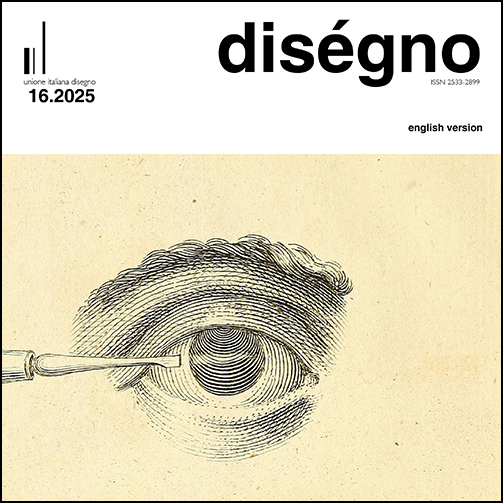Micro Relation Decodes: Movement, Boundaries and Materiality in Drawing
DOI:
https://doi.org/10.26375/disegno.16.2025.20Keywords:
tracing, micro relation, topography, drawing, performanceAbstract
This research explores how drawing and tracing have evolved into critical tools in scientific and political discourse. Tracing, once seen as mere reproduction, now involves transferring conditions, engaging with past events, and addressing urgent issues –particularly within forensic aesthetics. The study questions the epistemological status of traces, framing them as ontologically significant in both artistic and technical production. Drawing is approached as a performative act that reveals unsensed or unconscious micro-events. It extends beyond the body.
The research aims to conceptualize how tracing and drawing converge through the re-visualization of invisible. The political agency of drawing and its dialogical potential between abstraction and grounded realities. Simultaneously, it considers the aesthetic and technical dimensions of drawing as a dynamic, non-standard process. Tracing is redefined as performative –through choreography, erasure and evolving imagery– opening new paths for engaging space, perception and meaning.
References
Al-Ani, J. (2024). Jananne Al-Ani in Conversation. In Ars Orientalis, Vol. 54, pp. 171-181.
Bacon, R. (2024). What’s the Matter? An Exploration of the Shared Space between Drawing and Mining. In TRACEY - Drawing and Visualisation Research, Vol. 17(1), pp. 1-14. <https://ojs.lboro.ac.uk/index.php/TRACEY/article/view/390/366> (accessed 2 April 2025).
Ceylan, E. (2022). Canan Tolon: Hasar. İstanbul: Arter Yakın Plan.
Cramer, C., Grant, K. (2025). Surrealist techniques: Automatism.<https://www.khanacademy.org/humanities/art-1010/dada-and-surrealism/xdc974a79:surrealism/a/surrealist-techniques-automatism#:~:text=Automatism%20was%20a%20group%20of,virtually%20a%20synonym%20of%20Surrealism> (accessed 2 February 2025).
Derrida, J. (1990). Mémoires d’aveugle: L’autoportrait et autres ruines. Paris: Éditions de la Réunion des Musées Nationaux.
Dexter, E. (2005). To draw is to be human. In J. Burton, E. Dexter. Vitamin D: New perspectives in drawing, pp. 6-10. London, New York: Phaidon.
Douglas, M. (2007). Saflık ve Tehlike: Kirlilik ve Tabu Kavramlarının Bir Çözümlemesi. İstanbul: Metis.
Einstein, C. (2019). A Mythology of Forms: Selected Writings on Art. Chicago: University of Chicago Press.
FVU Frames (2022). Jananne Al-Ani, Timeline. <https://www.fvu.co.uk/projects/timelines> (accessed 14 February 2025).
<https://www.max-ernst.com/the-entire-city.jsp> (accessed 2 February 2025).
Hutter, H.R. (2025). Drawing. In Encyclopædia Britannica. <https://www.britannica.com/art/drawing-art> (accessed 14 February 2025).
Küçük, M. (11 May 2023). Mardin Fragmanları. Tozlu Bir Anlatı. <https://manifold.press/tozlu-bir-mardin-anlatisi> (accessed 2 February 2025).
Lash, M. (2009). Boxed in: Imagining the Unseen in Roberto Matta’s Cube Constructions. In RES: Anthropology and Aesthetics, Vol. 55-56, pp. 267-278.
Libeskind, D. (2001). Micromegas: The architecture of end space. In D. Libeskind, Radix-matrix: Architecture and writings, pp. 82-84. Munich: Prestel.
Lucarelli, F. (8 November 2015). Fracturing and Displacement of Form: Daniel Libeskind’s Early Collage Drawings (1967-1970). <https://socks-studio.com/2015/11/08/fracturing-and-displacement-of-form-daniel-libeskinds-early-collage-drawings-1967-1970/> (accessed 2 February 2025).
Lucio Fontana’s Spatial Concept, Waiting: A Dive into the Infinite. (2 April 2024). <https://www.singulart.com/blog/en/2024/04/02/spatial-concept-waiting-by-lucio-fontana/> (accessed 12 February 2025).
Matta, E. (1938). Mathématique sensible-Architecture du temps. In Minotaure, No. 11, p. 43.
McKenzie, J. (5 March 2015). Ilana Halperin: ‘Drawing is a trace fossil of a moment, an idea, proof of life’. <https://www.studiointernational.com/ilana-halperin-interview-geological-phenomena-volcanoes-drawing-photography-gallstones> (accessed 14 February 2025).
Milani, S., Schoonderbeek, M. (2012). Drawing Theory. An Introduction. In R. Marshall, P. Sawdon (Eds.). Hyperdrawing: beyond the lines of contemporary art, FOOTPRINT Delft School of Design Journal, Vol. 4(2), pp. 1-8. <https://journals.open.tudelft.nl/footprint/issue/view/379/352> (accessed 2 February 2025).
Robbins, H., Giaccardi, E., Karana, E., D’Olivo, P. (2015). Understanding and Designing with (and for) Material Traces. In Studies in Material Thinking, Vol. 13(1), pp. 1-24. <https://www.researchgate.net/publication/280727161_Understanding_and_Designing_with_and_for_Material_Traces> (accessed 12 February 2025).
Schuppli, S. (2020). Material Witness: Media, Forensics, Evidence. Cambridge, Massachusetts: MIT press.
Taylor, A. (2020). Why DRAWING matters. In Drawing: Research, Theory, Practice, Vol. 5(1), pp. 5-10.
Whitfield, S., Fontana, L., Gallery, H. (1999). Fontana. Oakland: University of California Press.
Downloads
Published
How to Cite
Issue
Section
License
Copyright (c) 2025 diségno

This work is licensed under a Creative Commons Attribution 4.0 International License.






